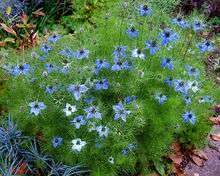Nigella damascena
Nigella damascena, love-in-a-mist,[1] ragged lady[2] or devil in the bush,[3] is an annual garden flowering plant, belonging to the buttercup family Ranunculaceae. It is native to southern Europe (but adventive in more northern countries of Europe), north Africa and southwest Asia, where it is found on neglected, damp patches of land.
| Nigella damascena | |
|---|---|
 | |
| Scientific classification | |
| Kingdom: | Plantae |
| Clade: | Tracheophytes |
| Clade: | Angiosperms |
| Clade: | Eudicots |
| Order: | Ranunculales |
| Family: | Ranunculaceae |
| Genus: | Nigella |
| Species: | N. damascena |
| Binomial name | |
| Nigella damascena | |
The specific epithet damascena relates to Damascus in Syria.[4] The plant's common name comes from the flower being nestled in a ring of multifid, lacy bracts.
Description
It grows to 20–50 cm (8–20 in) tall, with pinnately divided, thread-like, alternate leaves. The flowers, blooming in early summer, are most commonly different shades of blue, but can be white, pink, or pale purple, with 5 to 25 sepals. The actual petals are located at the base of the stamens and are minute and clawed. The sepals are the only colored part of the perianth. The four to five carpels of the compound pistil have each an erect style.[5]
The fruit is a large and inflated capsule, growing from a compound ovary, and is composed of several united follicles, each containing numerous seeds. This is rather exceptional for a member of the buttercup family. The capsule becomes brown in late summer. The plant self-seeds, growing on the same spot year after year.[6]
- Double form
 Seed capsule
Seed capsule Dried seed-heads with seeds
Dried seed-heads with seeds Seeds
Seeds
Cultivation

This easily grown plant has been a familiar subject in English cottage gardens since Elizabethan times, admired for its ferny foliage, spiky flowers and bulbous seed-heads. It is now widely cultivated throughout the temperate world, and numerous cultivars have been developed for garden use. 'Persian Jewels' is a mixture of white, pink, lavender and blue flowers. 'Persian Rose' is pale pink. Other cultivars are 'Albion', 'Blue Midget', 'Cambridge Blue', 'Mulberry Rose', and 'Oxford Blue'. 'Dwarf Moody Blue' is around 15 cm (6 in) high. The pale blue ‘Miss Jekyll’[7] and the double white-flowered 'Miss Jekyll Alba' have gained the Royal Horticultural Society's Award of Garden Merit.[8][9]
Related species
The related Nigella sativa (and not N. damascena) is the source of the spice variously known as nigella, kalonji or black cumin.
Alkaloids
Damascenine is a toxic alkaloid found in Nigella damascena seed.[10]
However, an in vivo study in mice and in vitro assessment on human cell lines has not shown any toxicity
References
- "BSBI List 2007". Botanical Society of Britain and Ireland. Archived from the original (xls) on 2014-10-23. Retrieved 2014-10-17.
- "Ragged lady". The Free Dictionary. Retrieved 17 August 2012.
- "Nigella damascena". Natural Resources Conservation Service PLANTS Database. USDA. Retrieved 20 July 2015.
- Harrison, Lorraine (2012). RHS Latin for gardeners. United Kingdom: Mitchell Beazley. p. 224. ISBN 9781845337315.
- Brickell, Christopher, ed. (2008). The Royal Horticultural Society A-Z Encyclopedia of Garden Plants. United Kingdom: Dorling Kindersley. p. 726. ISBN 9781405332965.
- "Nigella damascena". Encyclopedia of Life. Retrieved 13 April 2018.
- "RHS Plantfinder - Nigella damascena 'Miss Jekyll'". Retrieved 13 April 2018.
- "RHS Plant Selector - Nigella damascena 'Miss Jekyll Alba'". Retrieved 23 February 2020.
- "AGM Plants - Ornamental" (PDF). Royal Horticultural Society. July 2017. p. 69. Retrieved 13 April 2018.
- Margout, Delphine; Kelly, Mary T.; Meunier, Sylvie; Auinger, Doris; Pelissier, Yves; Larroque, Michel (2013). "Morphological, microscopic and chemical comparison between Nigella sativa L. cv (black cumin) and Nigella damascena L. cv". Journal of Food, Agriculture and Environment. 11 (1): 132–138.
![]()